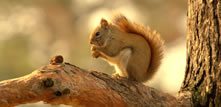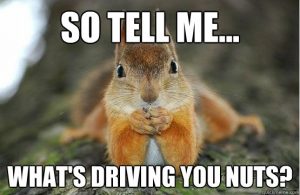Of all the wildlife found in the Chicago area, chipmunks are one of the most abundant animals and they can be found virtually anywhere due to their small size and burrowing abilities. For the most part, chipmunks are not a problem but they can become a problem if they invade your home or burrow too close to structural elements such as porches or patios. It is important for homeowners to keep an eye out for chipmunks on their property and make sure they stay under control.
Chipmunk Behaviors
Chipmunks are small rodents that are only 5 to 6 inches long with dark and tan stripes down its back and the sides of its face. They are known for their burrowing and often hide their burrows near objects or buildings such as tree stumps, brush piles, and houses. The entrance to chipmunk burrows has a diameter of about 2 inches with no mounds of dirt around it because chipmunks carry the dirt away from the burrow in their cheek pouches.
Chipmunks live on a diet made up of grains, nuts, berries, seeds, and insects and they will climb trees for nuts, fruits, and seeds. They spend the year gathering food to store in their burrows and by storing seeds they help promote new plant growth.
Chipmunk Control
Chipmunks typically become a problem for homeowners when they gather in large numbers on a property or make their way inside a home or garage. Too many chipmunks in your yard can cause problems with their burrowing because they like to build their burrows near other objects such as patios, decks, stairs, and retention walls which can lead to structural damage. They can also be a nuisance by eating flowers, seeds, and pet food that is not properly sealed.
In addition to causing problems in the yard, chipmunks can also cause a range of problems inside the home. Chipmunks can make their way inside wall cavities, attics, or crawlspaces where they destroy drywall and chew on wires which increases the risk of fire. They can also destroy property with fecal contamination and they give off a strong odor when they die.
The best method of chipmunk control is prevention but if an infestation does occur, the most effective way to remove them is with live trapping by a certified professional. To keep chipmunks out of your home, close off any possible entry points with hardware cloth, caulking, or steel wool. Remember that chipmunks can fit through very tiny spaces when looking for entry points.
As soon as you suspect you may have a chipmunk infestation, call us immediately at 847-464-1861 for removal. We are trained professionals and equipped to deal with chipmunk exclusion and removal, including humane live animal trapping (never poisons!). We will remove the chipmunks and fix any property damage they may have caused. Click to read more about chipmunk removal services from Attic Solutions.




 Squirrels are one of the most common nuisance animals that invade homes and yards and they tend to find their way into the attic of a home.
Squirrels are one of the most common nuisance animals that invade homes and yards and they tend to find their way into the attic of a home. Preventing Squirrel Infestations
Preventing Squirrel Infestations Imagine you are in your bed, happy to be lying down after a long day but your rest is abruptly interrupted by loud scratching noises coming from your walls or attic.
Imagine you are in your bed, happy to be lying down after a long day but your rest is abruptly interrupted by loud scratching noises coming from your walls or attic.